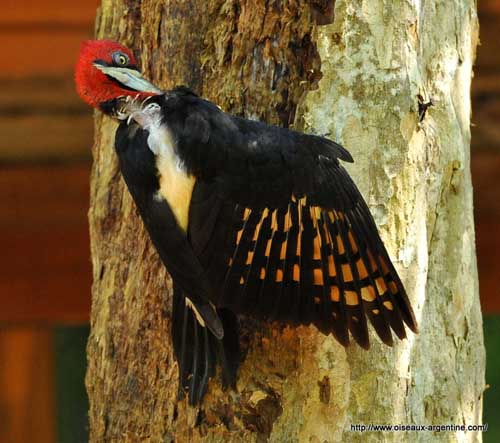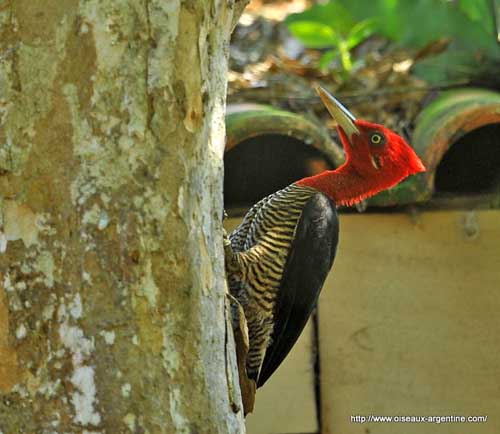
Fr: Pic robuste
All : Scharlachkopfspecht
Esp : Picamaderos Robusto
Ital : Picchio robusto
Nd: Grote Roodkopspecht
Sd: Vitryggad jättespett
Port: Pica-pau-rei
Photographers:
Philippe et Aline Wolfer
GALERIE
Text by Nicole Bouglouan
Sources:
HANDBOOK OF THE BIRDS OF THE WORLD Vol. 7 by Josep del Hoyo-Andrew Elliott-Jordi Sargatal – Lynx Edicions – ISBN: 8487334377
BirdLife International (BirdLife International)
Wikipedia, la enciclopedia libre
The Cornell Lab of Ornithology – Neotropical birds
Robust Woodpecker
Campephilus robustus
Piciforme Order – Picidae Family
BIOMETRICS:
Length: 32-37 cm
Weight: 230-294 gr
DESCRIPTION:
As the members of genus Campephilus which gathers some of the largest woodpeckers, the Robust Woodpecker is a large bird.
The adult male has bright red head, crest and neck. It shows a small black and white spot on lower ear-coverts. On neck and head sides, feathers may have black and buff bases often visible, but mainly in worn plumage.
The upperparts are whitish, often washed pale buff or cinnamon. There are some black bars on upper mantle and at sides. On the upperwing, coverts and scapulars are black, and the inner webs of the flight feathers show rusty-buff spots, more conspicuous in flight. The uppertail is black.
On the underparts, the upper breast is bright red. Rest of underparts are whitish-buff barred black. The belly often shows narrower bars or occasionally lacks them. On the blackish-brown underwing, coverts are rufous-buff and flight feathers are spotted as above.
The bill is horn-coloured, almost straight and chisel-shaped. The eyes are whitish to yellowish-white, surrounded by dark feathered eyering. Legs and feet are dark grey.

The female is almost similar, but she lacks the black and white spot on ear-coverts. She has whitish bill base extending to lower ear-coverts. This white malar stripe is edged black above and below. The chin is black too.

The juvenile is duller and browner. The barring on the underparts is less contrasted, and the undertail-coverts are often unbarred. It has whiter upperparts and the same head pattern as adult female. The young male shows red tips in the malar area.
VOICE: SOUNDS BY XENO-CANTO
The Robust Woodpecker utters some short calls when perched or in flight: “kee” or “kew”, and series such as “pso-ko po-po-po-po-rrat”.
This species produces peculiar drumming, a double tap “to-plop” or “thump-ump”, given 1-3 times per minute. These sounds betray its presence in the dense humid forest of South America, and are used to maintain contact between the members of a group.
HABITAT:
The Robust Woodpecker frequents humid Araucaria forest. It also may occur in disturbed forest where large trees are available.
This species is visible in lowlands to 1000 metres and in hills to 2200 metres of elevation.
RANGE:
The Robust Woodpecker is found from E Brazil to E Paraguay, NE Argentina and Río Grande do Sul in Brazil.

BEHAVIOUR:
The Robust Woodpecker can be seen singly or in pairs, and in family groups. This species feeds on beetles and wood-boring insect larvae. It may also take seeds and berries.
It is rarely seen on the ground, preferring to forage at middle storey level. But as it prefers dead or living large trees, it can forage at all levels. Trunks and base of branches are visited, removing the bark and probing, thanks to the long bill. It also pecks and hammers strongly.

The breeding behaviour of this species is poorly known. However, the Robust Woodpecker performs wing-spreading in order to display the spotted wing pattern, and to expose the whitish parts of upperparts or the barred pattern of underparts. Other displays are probably performed with the red crest raised, and aerial displays too.
The Robust Woodpecker is resident in its range, and probably defends its territory all year round. Woodpeckers advertise their presence by giving vocal signals and by drumming. The male drums more than the female.
FLIGHT:
The Robust Woodpecker performs undulating flight as all Picidae species.

REPRODUCTION:
The Robust Woodpecker excavates holes in trees for nesting. This big woodpecker prepares a large cavity entrance, adapted to its size. The nest-chamber is pear-shaped, excavated in soft inner core by both mates.
The nest-site, the tree which shelters the hole, is usually at the edge of the territory, often in more open habitat, and with good orientation for protection from bad weather.
The female lays 2-4 white eggs, and both parents incubate during 12-15 days. The chicks are fed by both adults at nest during the first ten days, and then, they wait for parents at the entrance where the adults feed them. They leave the nest about 26-28 days after hatching.

DIET:
The Robust Woodpecker feeds on wood-boring insect larvae and beetles, and also consumes seeds and berries according to the season.
PROTECTION / THREATS / STATUS:
The Robust Woodpecker is usually uncommon throughout the range. Some increase of the habitat is suspected into Río Grande do Sul in Brazil.
Currently, this species has stable populations and is not globally threatened.
